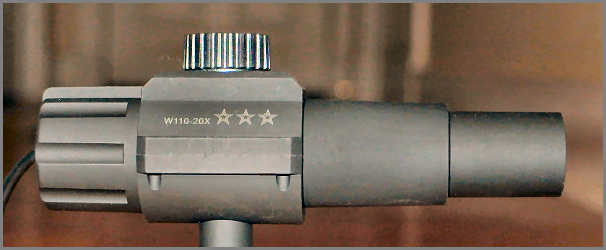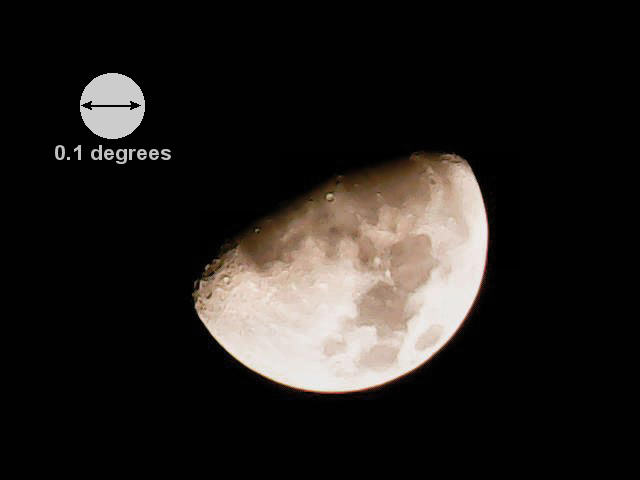Moon Camera for EME
Tracking the moon with an EME antenna can be done in a number of ways, from a fully automatic system to a manually operated motorized system to a fully manual system. In each case some sort of altitude and azimuth feedback is required so you know where the antenna is pointing. One way of getting this feedback when you can see the moon is visually confirm the array is pointing at the moon and the easiest way to do this (other then running outside and looking for yourself) is to add a moon camera.
I found the following camera on eBay. It's chinese of course, and it's advertised as a 70x zoom, 2MP USB "Telescope Camera". Sounds great but is it?

"W110 Multi-function Smart Telescopic 70X Zoom HD 2Mega Camera For Outdoor Sports"
First it's not a zoom. It's a fixed focal length lens. Second it doesn't appear to be 2MP. It appears to be a 640x480 pixel camera (0.3MP), at least that's the largest image I could get it to display. I tried several different webcam display programs and they all gave a 640x480 image. 2MP would be 1200 by 1600 pixels. Maybe there's some way you can get it to deliver 2mp, but I couldn't find one. Third, it may or may not be 70x - depending on how you define 1x. To add to the confusion, it's marked as "W110-20X", though again, 20x what? If you've bought many Chinese consumer electronic or optical items from eBay, you'll realize that this is pretty much par of the course, so I wasn't too surprised. You can't believe much in the way of technical specifications. However for this application, the specs don't really matter.
So the question is whether you can you it as a moon tracking camera on an EME antenna? The answer is probably yes. Below is an example screen shot:

Image quality is good enough for tracking the moon. It seems to be able to automatically control the image brightness, even with the moon in a clear dark sky. Operation is simple. You plus it into a USB port and run you video display software. It comes with a disk with software, but there are lots of free programs to do this. I use OASIS.exe (http://www.oasisscientific.com/downloads.html). The supplied software can display images from up to 4 cameras at the same time and can be set to sound alarms if anything moves in the frame. It seems to be designed for security applications. I found it be be somewhat unstable (running under Windows 7). It would work, but it would lock up if I tried to select some menu options.
I measured the field of view as about 1 degree horizontal by 0.75 degrees vertical (about 1.25 degrees diagonal). That's pretty tight, but for accurately aiming a dish at the moon, a tight field of view is what you want. If you have a Yagi array with a fairly large beanwidth and it's blows around in the wind, the image of the moon may well shift outside the field of view and this may not really matter with most antennas on the lower EME bands. However with a decent size dish on the higher bands you would certainly not want the moon to move outside the display. With a 2m dish on 10GHz, you will be 3dB down if you are 1 degree off the moon.
The camera has a 1/4-20 threaded socket on the base which makes mounting easy. There's a large focusing knob on the top, but for moon use, once it's set for infinity you don't need to adjust it again. It's fixed in length (~6") and it's very light. It looks like the lens might retract, but it doesn't. Focusing is internals so the length stays constant. I'm 99.99% certain it's not waterproof, but it shouldn't be hard to mount it inside a waterproof tube with a windows on the front. It comes with a small tripod which isn't terribly useful,
Prices range from about $35 direct from China (it can take a month or more to get here thought) to $45-$55 from US suppliers. The US suppliers are just warehouses full of imported items. The vendors know nothing about what they are selling. However buying from one of the US distributors does make it a LOT easier to return the camera if it doesn't work or you just don't like it.
This may not be the ideal variable magnification, waterproof, moon tracking camera, but it's a turnkey solution. You plug it in and it (hopefully) works. You will probably also need a powered USB extension cable if you want to run it in a remote location. Be aware of the cable length limitation of USB cables. A USB 2.0 cable should be 5m (16ft) or less for reliable operation. To go further than that you need a special powered (repeater) cable of other type of extender (USB -> Ethernet -> USB for example). The cable attached to the camera is about 1.5m (5ft)long.
Is it worth $50? Probably not. It's a cheap, plastic, low resolution webcam stuck on the end of a simple lens system. Does it provide a closeup view of the moon that could be used for antenna tracking? Yes, it can do that. The magnification is high enough that, if properly aligned, it could, in principle, enable an antenna to be pointed at the moon (when visible) with an accuracy of maybe 0.1 degrees. If the moon is visible anywhere on the screen at all, you're probably within about 0.75 degrees.
Drawbackes of a USB moon Camera
(1) It only helps when you can see the moon. The moon is often hard (or impossible) to see during the day and impossible to see though clouds, day or night!(2) It's not waterproof (needs a waterproof housing for permanent installation)
(2) There can be RFI on some bands from some USB connections. I don't see anything on 1296 with my PC and the cables I use, but with a different cable on a different PC and a different band, there could be an RFI issue.
.jpg)